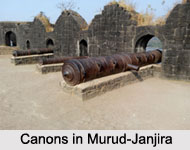 Murud-Janjira is an island fort that was erected with the late Mughal art and architecture. This fort is located geographically in a village of Maharashtra named Murud in Raigad District of western Indian state of Maharashtra.
Murud-Janjira is an island fort that was erected with the late Mughal art and architecture. This fort is located geographically in a village of Maharashtra named Murud in Raigad District of western Indian state of Maharashtra.
Naming of Murud-Janjira
Murud-Janjira is name of non indigenous origin. The word "Janjira" is not native to India. It is noted that this word is originated in Arabic dictionary. The Arabic word "Jazeera" means an island. The village of Murud was once known in Marathi language as Habsan. The name of this medieval fort is a mix of the Konkani language and Arabic language.
History of Murud-Janjira
Murud-Janjira was built in the medieval era. It played an important role in creating the history before the invasion of Maratha Empire and British Empire in India. It was the property of Sultans of Ahmednagar. This fort was guarded by the water bodies as it is located on an island. Malik Ambar who was in service of Sultan of Ahmednagar designed as erected this magnificent island fort at the end of 17th Century. It belonged to Nizam Shahi dynasty. Murud-Janjira eye witnessed many foreign invasions and still remained intact. The Maratha Empire, Dutch East India Company and the British East India Company invaded various times to capture the fort. It served as the guarding point of the medieval maritime activities in west India. After the decline of Nizam Shahi Dynasty, Adil Shah Dynasty captured the fort and ruled from here till the reign of Ibrahim II. During the rule of Aurangzeb, this fort saved Aurangabad several times from the European warships. Later the Maratha Emperor Shivaji and his son Sambhaji invaded several times but were failed. Sambhaji also built another fort near Murud-Janjira called Padmadurg to challenge, but repeatedly he failed. It remained unconquered even today also. It was merged with British Empire in India in 1858. After 1947, Murud-Janjira became an integral part of India. 
Architecture of Murud-Janjira
Murud-Janjira was built in Persian and Mughal style in art and architecture. This fort is situated on an oval shaped rock off the Arabian Sea. Murud is a port city and it is 165 kilometers from Mumbai. It is approached by the ferry system. The main gate of Murud-Janjira faces Rajapouri on the sea shore. This fort has 26 round bastions which are still intact. The canons are also intact.
Tourism in Murud-Janjira
Murud-Janjira is now a tourism attraction. There are three gigantic canons named Kalalbangdi, Chavri and Landa Kasam which served for security against British and Marathas. These are now historical figures. One can also see the panoramic view of the sea from the bastions. Inside the fort there are palaces, soldier quarter, mosques and a fresh water lake. The palace for Nawabs of Murud is still in good condition.



















